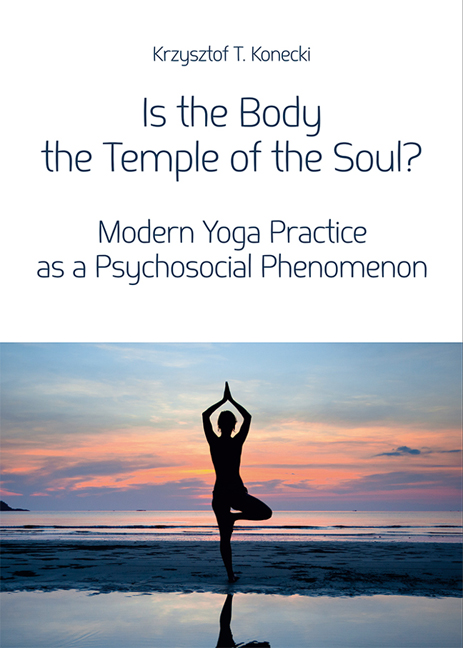Book contents
- Frontmatter
- Contents
- Foreword (Michał Szczepanik)
- Introduction
- Chapter 1 Philosophy and hatha-yoga practice. Para-religious aspects of hatha-yoga
- Chapter 2 The social world of yoga practice
- Chapter 3 Commonsense definitions of yoga and its meaning for practitioners
- Chapter 4 The process of becoming a hatha-yoga practitioner
- Chapter 5 Visual transmission of knowledge and the meaning of corporality and gestures in the social world of yoga practice
- Chapter 6 Emotions and yoga practicing. Working on emotions and achieving “emotional culture” without emotions
- Chapter 7 Teacher and guru in hatha-yoga practice
- Conclusions
- Bibliography
Chapter 1 - Philosophy and hatha-yoga practice. Para-religious aspects of hatha-yoga
Published online by Cambridge University Press: 10 January 2018
- Frontmatter
- Contents
- Foreword (Michał Szczepanik)
- Introduction
- Chapter 1 Philosophy and hatha-yoga practice. Para-religious aspects of hatha-yoga
- Chapter 2 The social world of yoga practice
- Chapter 3 Commonsense definitions of yoga and its meaning for practitioners
- Chapter 4 The process of becoming a hatha-yoga practitioner
- Chapter 5 Visual transmission of knowledge and the meaning of corporality and gestures in the social world of yoga practice
- Chapter 6 Emotions and yoga practicing. Working on emotions and achieving “emotional culture” without emotions
- Chapter 7 Teacher and guru in hatha-yoga practice
- Conclusions
- Bibliography
Summary
Introduction
The explanation of what hatha-yoga is seems a difficult task for a sociologist. I am even more aware, since practicing yoga and observing yoga practitioners and listening to their explanations, of the wide array of common definitions of yoga, as well as the many types of yoga. People who practice different types of yoga usually treat the given type which they practice as the source, and even sometimes as the one and only true source, of that which can be called yoga. While we will deal with the problem of a common definition of yoga by practitioners in Chapter 3, at this point we will examine how yoga is defined by a religious historian and theologian, Mircea Eliade, and a practitioner and theoretician of yoga, Bellur Krishnamachar Sundararaja Iyengar, who is a spiritual guardian, teacher, and master (guru) in his own line of yoga teaching, often called Iyengar's School.
Iyengar has created a very buoyant B. K. S. Iyengar's Institute of Yoga in Pune, India, which educates teachers propagating hatha-yoga around the world. Iyengar (December 14, 1918–August 20, 2014) wrote several books that explain his philosophy of yoga and also gave instructions for executing certain asanas (positions) and breathing practices (pranayama). During his youth, Iyengar cured himself from many physical ailments and sicknesses through yoga practices (2005a). Maybe this biographical fact established his strong tendency to accent physicality and physical exercises in his concept of hatha-yoga. He is often accused of having a physical approach to yoga. However, in order to level this tendency in his work and in the perception of his school, he wrote a book after 70 years of practice, Light on Life, which shows other elements of yoga, accenting more the spirituality of this philosophy, and also translated and explained Patanjali's sutras, which express the essence of yoga and show its spiritual character (Iyengar 2002a; 2005a).
- Type
- Chapter
- Information
- Is the Body the Temple of the Soul?Modern Yoga Practice as a Psychosocial Phenomenon, pp. 21 - 38Publisher: Jagiellonian University PressPrint publication year: 2016



